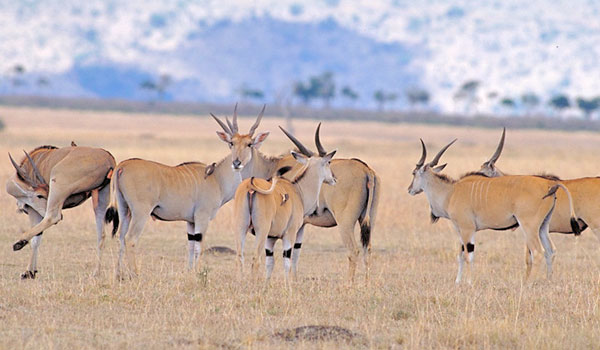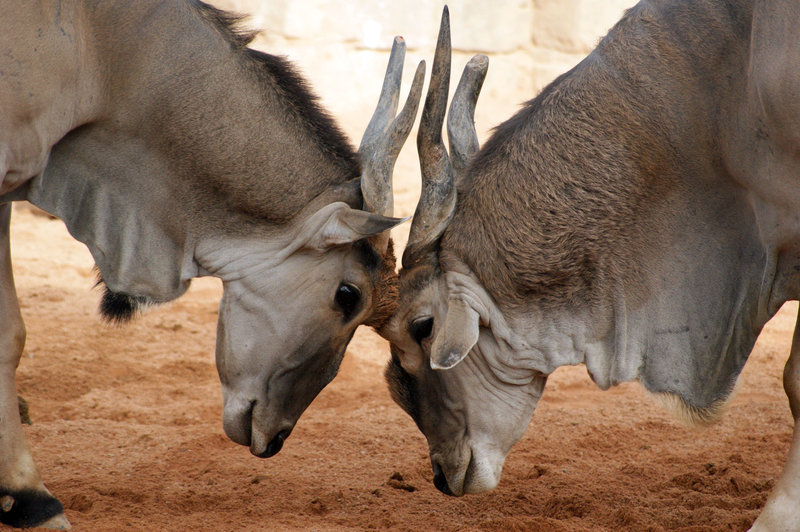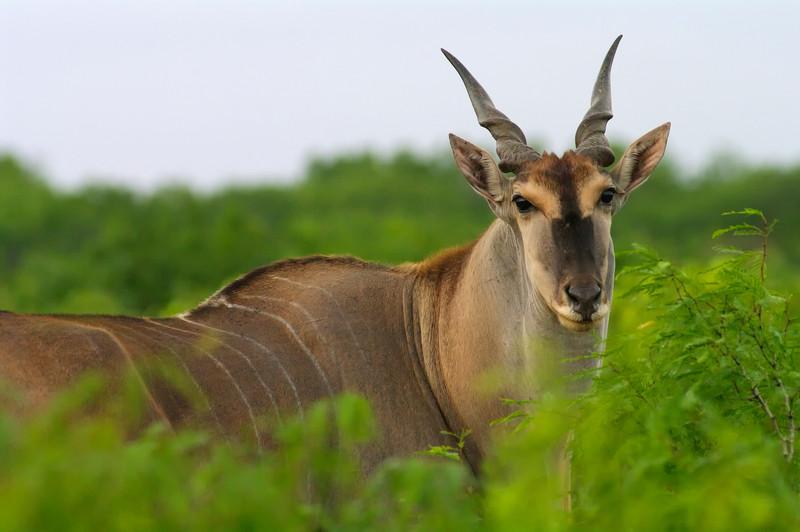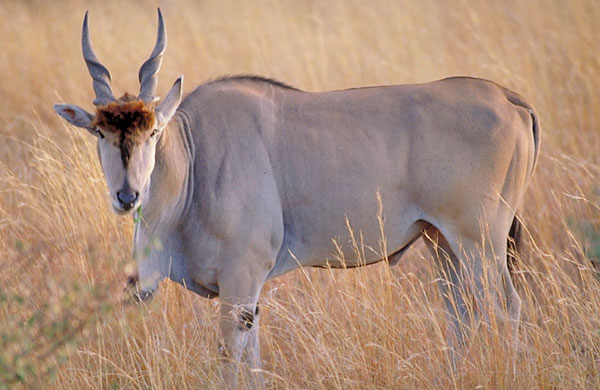



Eland antilopa
Eland antilopa (lat. Taurotragus oryx) - vrsta antilope iz roda Taurotragus.
Živi u savanama i ravnicama u istočnoj i južnoj Africi. Peter Simon Pallas prvi put je opisao vrstu 1766. godine.
Odrasli mužjak prosječno je visok oko 1,6 metara u ramenima, a ženke su oko 20 cm niže. Mužjaci prosječno teže 500-600 kilograma, a ženke 340-445 kilograma. To je druga najveća antilopa u svijetu, poslije vrste Taurotragus derbianus.
Uglavnom su biljojedi, hrane se prvenstveno travom i lišćem. Grupiraju se u stada do 500 životinja, ali nisu vezani za teritorij. Preferiraju staništa poput savana, šuma te otvorenih i gorskih travnjaka. Izbjegavaju guste šume. Glasaju se slično lajanju. Komuniciraju i govorom tijela. Korisna je ljudima, zbog hranjivog mlijeka i upotrebljive kože pa se negdje i uzgaja.
Kao i mnogi papkari, mužjaci elanda se bore za dominaciju i za priliku da se pare sa ženkama. Oni se bodu rogovima dok jedan ne odustane i povuče se. Brojnost se smanjuje, ali još uvijek nije ugrožena.
jávorantilop
A jávorantilop (Taurotragus oryx, olykor Tragelaphus oryx) a párosujjú patások rendjébe, ezen belül a tülkösszarvúak családjába és a tulokformák alcsaládjába tartozó afrikai kérődző, a világ egyik legtermetesebb antilopfaja. Neve a búr telepesektől ered, akik annak idején a jávorszarvas jelentésű eland nevet adták neki.
A jávorantilop igen impozáns megjelenésű állat. Alapszíne vöröses vagy homokszínű-világosbarna, hátról gyakran néhány vékony fehér csík fut hasa felé. A bikák sötétebb alapszínűek. A has és a lábak világosak, bár a térdrészen sötét, feketés foltok fordulhatnak elő. Az arckoponyát fedő szőrzet is sötétebb színű. A nyak alsó részén vérerekben gazdag toroklebeny csüng, amely az idős bikáknál különösen nagy is lehet. Ennek szerepe a hőleadásban van. A bikákra borzas, sötét, durva szőrű homloksörény is jellemző.
A bikák sokkal nagyobbak a teheneknél: tömegük 400 kilogrammtól kezdve 1 tonnáig terjed, szemben a nőstények 300-600 kilogrammjával, és 3 métert megközelítő testhosszuk is nagyobb a legkevesebb 2 méteres tehenekénél.
Common eland
The common eland (Taurotragus oryx), also known as the southern eland or eland antelope, is a savannah and plains antelope found in East and Southern Africa. It is a species of the family Bovidae and genus Taurotragus. It was first described by Peter Simon Pallas in 1766. An adult male is around 1.6 metres (5') tall at the shoulder (females are 20 centimetres (8") shorter) and can weigh up to 942 kg (2,077 lb) with an average of 500–600 kg (1,100–1,300 lb), 340–445 kg (750–981 lb) for females). It is the second largest antelope in the world, being slightly smaller on average than the giant eland. Mainly a herbivore, its diet is primarily grasses and leaves. Common elands form herds of up to 500 animals, but are not territorial. The common eland prefers habitats with a wide variety of flowering plants such as savannah, woodlands, and open and montane grasslands; it avoids dense forests. It uses loud barks, visual and postural movements and the flehmen response to communicate and warn others of danger. The common eland is used by humans for leather, meat, and rich, nutritious milk, and has been domesticated in many areas.
Fischotter
Die Elenantilopen werden auch Elandantilopen genannt. Sie sind etwa so groß wie ein Pferd. Sie messen am Widerrist ca. 1,75 m und wiegen 450 bis 900 kg. Männliche und weibliche Tiere tragen aufrecht wachsende Hörner, die bis zu 1,20 m lang werden. Trotz ihrer Größe können sie sehr gut springen. Elenantilopen ernähren sich von Blättern und Früchten. Mit ihren Hufen scharren sie Wurzeln aus dem Boden. Zu einer Herde gehören etwa 25 bis 70 Tiere. Einmal täglich suchen sie eine Wasserstelle auf. Manchmal leben sie auch mit Zebras zusammen. Löwen, Geparden, Leoparden und Hyänen stellen ihnen nach. Man bemüht sich, Elenantilopen zu Haustieren zu machen oder sie mit Hausrindern zu kreuzen. Sie sind viel besser als Hausrinder gegen Krankheiten geschützt.

